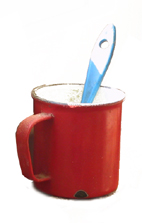The properties of glues vary a lot. Glue’s moisture resistance, dry matter content, viscosity, acidity and ageing properties are factors that affect gluing.
Dry matter content
Glues from which the solvent evaporates are used for gluing wood. The dry matter forms the actual joint. When the solvent evaporates, the joint shrinks, which creates tensions. The amount of shrinkage depends on the dry matter content and the thickness of the joint.
Viscosity
The proper viscosity of glue depends on several matters. Adding filling material or additives can increase the viscosity of glue. Respectively, adding solvent, which is often water in wood glues, can reduce the viscosity of glue. When gluing porous and moist wood, thick glue must be used, so that the glue will not absorb too much into the wood.
When gluing thin veneers, it is necessary to use thick glue, so that the glue will not penetrate the veneer. When using heat in compressing, temporary decreasing of viscosity at the beginning has to be taken into account. It may cause excessive absorption of the glue into the wood.
Acidity
The acidity of glue is reported in pH numbers. Wood is slightly acid, so it normally endures acids well. Hard acids, the hardeners of glues, may damage wood. Alkaline glues cause colour defects to some tree species (e.g. oak and mahogany). The closer the pH number of the glue is to neutral, the better.
The pH number of chemically hardening glues is a very significant factor. For example, the hardening of urea-formaldehyde resins depends fundamentally on the acidity of the solution.
Ageing
Glue joints may weaken in the long run. The operating conditions and the aging resistance properties determine the durability of the glue joint. Gluing done in room temperature, which utilizes acid hardener, accelerates embrittlement. Adding softening modifier regulators, filling material or additives can prevent the embrittlement of the glue joint.